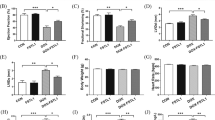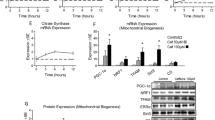Abstract
The aim is to study the effects and underlying mechanisms of astragalus polysaccharide (APS) on the peroxide-induced injury in C2C12 myoblasts in vitro. Cell viability in the presence or absence of APS was detected by the methyl thiazolyl tetrazolium colorimetric assay. The autophagosomes were observed by electron microscopy to examine the influence of APS on autophagy caused by H2O2 in C2C12 cells, and the percentage of apoptosis cells was measured by flow cytometry. To further confirm the effect of H2O2 on C2C12 cells, the protein expression of LC3 and RARP, which are the markers of autophagy and apoptosis, respectively, was analyzed by Western blot, as well as the expression levels of p-p70S6K, p70S6K, Bcl-2, Bax, cyto-C, and Caspase-3, to reveal the underlying mechanisms. We observed multiple effects of APS on C2C12 functionality. APS treatment of C2C12 cells at 1 mg/mL reduced cell viability to less than 70 %, and analysis by electron microscopy revealed that APS also reduced the number of H2O2-induced autophagosome formation. Similarly, APS abated the H2O2-mediated increase in cell apoptosis, which was accompanied by the inhibition of LC3 II and RARP that are normally upregulated by H2O2. The expression of p-p70S6K and p70S6K, however, remained unchanged in C2C12 cells in the Control, H2O2 and H2O2 + APS groups. In addition, APS promoted the expression of protein Bcl-2 in H2O2-treated C2C12 cells, but did not change Bax, thus reducing the Bax/Bcl-2 ratio that in turn prevented the release of cytochrome c and the activation of caspase-3. APS inhibits the autophagy and apoptosis induced by peroxide injury in C2C12 myoblasts through two independent signaling pathways: the mTOR-independent pathway for the inhibition of autophagy, and the caspase-3-dependent pathway for the suppression of apoptosis.




Similar content being viewed by others
References
Lecker, S. H., Goldberg, A. L., & Mitch, W. E. (2006). Protein degradation by the ubiquitin-proteasome pathway in normal and disease states. Journal of the American Society of Nephrology, 17, 1807–1819.
Sandri, M. (2008). Signaling in muscle atrophy and hypertrophy. Physiology (Bethesda), 23, 160–170.
Glass, D. J. (2003). Molecular mechanisms modulating muscle mass. Trends in Molecular Medicine, 9(8), 344–350.
Cai, D., Frantz, J. D., Tawa, N. E, Jr, Melendez, P. A., Oh, B. C., Lidov, H. G., et al. (2004). IKKbeta/NF-kappaB activation causes severe muscle wasting in mice. Cell, 119(2), 285–298.
Welle, S. L. (2009). Myostatin and muscle fiber size. Focus on “Smad2 and 3 transcription factors control muscle mass in adulthood” and “Myostatin reduces Akt/TORC1/p70S6K signaling, inhibiting myoblast differentiation and myotube size”. American Journal of Physiology. Cell Physiology, 296(6), C1245–C1247.
Sachdev, S., & Davies, K. J. (2008). Production, detection, and adaptive responses to free radicals in exercise. Free Radical Biology and Medicine, 44(2), 215–223.
Kerkweg, U., Petrat, F., Korth, H. G., & de Groot, H. (2007). Disruption of skeletal myocytes initiates superoxide release: contribution of NADPH oxidase. Shock, 27(5), 552–558.
Sim, M. K., Wong, Y. C., Xu, X. G., & Loke, W. K. (2014). Des-aspartate-angiotensin I attenuates ICAM-1 formation in hydrogen peroxide-treated C2C12 skeletal muscle cells and soleus muscle of mice subjected to eccentric exercise. Regulatory Peptides, 188, 40–45.
del Rio, L. A., Sandalio, L. M., Corpas, F. J., Palma, J. M., & Barroso, J. B. (2006). Reactive oxygen species and reactive nitrogen species in peroxisomes. Production, scavenging, and role in cell signaling. Plant Physiology, 141(2), 330–335.
Cheng, X. D., Jia, X. B., Feng, L., & Jiang, J. (2013). Study thought of material basis of secondary development of major traditional Chinese medicine varieties on basis of combination of in vivo and in vitro experiments. Zhongguo Zhong yao za zhi = Zhongguo zhongyao zazhi = China Journal of Chinese Materia Medica, 38(23), 4174–4180.
Liu, Y. Q., Xin, T. R., Lu, X. Y., Ji, Q., Jin, Y., & Yang, H. D. (2007). Memory performance of hypercholesterolemic mice in response to treatment with soy isoflavones. Neuroscience Research, 57(4), 544–549.
Zhang, C. L., Ren, H. J., Liu, M. M., Li, X. G., de Sun, L., Li, N., & Ming, L. (2014). Modulation of intestinal epithelial cell proliferation, migration, and differentiation in vitro by Astragalus polysaccharides. PLoS ONE, 9(8), e106674.
Chen, H. L., Li, D. F., Chang, B. Y., Gong, L. M., Dai, J. G., & Yi, G. F. (2003). Effects of Chinese herbal polysaccharides on the immunity and growth performance of young broilers. Poultry Science, 82(3), 364–370.
Dang, S. S., Jia, X. L., Song, P., Cheng, Y. A., Zhang, X., Sun, M. Z., & Liu, E. Q. (2009). Inhibitory effect of emodin and Astragalus polysaccharide on the replication of HBV. World Journal of Gastroenterology : WJG, 15(45), 5669–5673.
Guo, F. C., Kwakkel, R. P., Williams, C. B., Suo, X., Li, W. K., & Verstegen, M. W. (2005). Coccidiosis immunization: effects of mushroom and herb polysaccharides on immune responses of chickens infected with Eimeria tenella. Avian Diseases, 49(1), 70–73.
Guo, F. C., Williams, B. A., Kwakkel, R. P., Li, H. S., Li, X. P., Luo, J. Y., et al. (2004). Effects of mushroom and herb polysaccharides, as alternatives for an antibiotic, on the cecal microbial ecosystem in broiler chickens. Poultry Science, 83(2), 175–182.
Tin, M. M., Cho, C. H., Chan, K., James, A. E., & Ko, J. K. (2007). Astragalus saponins induce growth inhibition and apoptosis in human colon cancer cells and tumor xenograft. Carcinogenesis, 28(6), 1347–1355.
Guo, L., Bai, S. P., Zhao, L., & Wang, X. H. (2012). Astragalus polysaccharide injection integrated with vinorelbine and cisplatin for patients with advanced non-small cell lung cancer: effects on quality of life and survival. Medical Oncology, 29(3), 1656–1662.
Liu, X. N., Zhang, C. Y., Jin, X. D., Li, Y. Z., Zheng, X. Z., & Li, L. (2007). Inhibitory effect of schisandrin B on gastric cancer cells in vitro. World Journal of Gastroenterology : WJG, 13(48), 6506–6511.
Zhao, P., Su, G., Xiao, X., Hao, E., Zhu, X., & Ren, J. (2008). Chinese medicinal herb Radix Astragali suppresses cardiac contractile dysfunction and inflammation in a rat model of autoimmune myocarditis. Toxicology Letters, 182(1–3), 29–35.
Liu, M., Wu, K., Mao, X., Wu, Y., & Ouyang, J. (2010). Astragalus polysaccharide improves insulin sensitivity in KKAy mice: regulation of PKB/GLUT4 signaling in skeletal muscle. Journal of Ethnopharmacology, 127(1), 32–37.
Lu, L., Wang, D. T., Shi, Y., Yin, Y., Wei, L. B., Zou, Y. C., et al. (2013). Astragalus polysaccharide improves muscle atrophy from dexamethasone- and peroxide-induced injury in vitro. International Journal of Biological Macromolecules, 61, 7–16.
Ku, B. M., Lee, Y. K., Jeong, J. Y., Ryu, J., Choi, J., Kim, J. S., et al. (2011). Caffeine inhibits cell proliferation and regulates PKA/GSK3beta pathways in U87MG human glioma cells. Molecules and Cells, 31(3), 275–279.
Kamsteeg, M., Rutherford, T., Sapi, E., Hanczaruk, B., Shahabi, S., Flick, M., et al. (2003). Phenoxodiol–an isoflavone analog–induces apoptosis in chemoresistant ovarian cancer cells. Oncogene, 22(17), 2611–2620.
Kruger, N. J. (1994). The Bradford method for protein quantitation. Methods in Molecular Biology, 32, 9–15.
Bongers, K. S., Fox, D. K., Kunkel, S. D., Stebounova, L. V., Murry, D. J., Pufall, M. A. et al. (2014). Spermine oxidase maintains basal skeletal muscle gene expression and fiber size, and is strongly repressed by conditions that cause skeletal muscle atrophy. American Journal of Physiology Endocrinology and Metabolism, ajpendo 00472 02014.
Bodine, S. C. (2013). Disuse-induced muscle wasting. The International Journal of Biochemistry & Cell Biology, 45(10), 2200–2208.
Fry, C. S., & Rasmussen, B. B. (2011). Skeletal muscle protein balance and metabolism in the elderly. Current Aging Science, 4(3), 260–268.
Li, F., Li, Y., Tang, Y., Lin, B., Kong, X., Oladele, O. A., & Yin, Y. (2014). Protective effect of myokine IL-15 against H2O 2-mediated oxidative stress in skeletal muscle cells. Molecular Biology Reports, 41(11), 7715–7722.
Yang, M., Lin, H. B., Gong, S., Chen, P. Y., Geng, L. L., Zeng, Y. M., & Li, D. Y. (2014). Effect of Astragalus polysaccharides on expression of TNF-alpha, IL-1beta and NFATc4 in a rat model of experimental colitis. Cytokine.
Yang, Z., & Klionsky, D. J. (2009). An overview of the molecular mechanism of autophagy. Current Topics in Microbiology and Immunology, 335, 1–32.
Mammucari, C., Schiaffino, S., & Sandri, M. (2008). Downstream of Akt: FoxO3 and mTOR in the regulation of autophagy in skeletal muscle. Autophagy, 4, 524–526.
Wang, W., Wen, Q., Xu, L., Xie, G., Li, J., Luo, J., et al. (2014). Activation of Akt/mTOR pathway is associated with poor prognosis of nasopharyngeal carcinoma. PLoS ONE, 9(8), e106098.
Wang, W. K., Lin, S. T., Chang, W. W., Liu, L. W., Li, T. Y., Kuo, C. Y., Hsieh, J. L., & Lee, C. H. (2014) Hinokitiol induces autophagy in murine breast and colorectal cancer cells. Environmental Toxicology.
Li, G. Y., Xie, P., Li, H. Y., Hao, L., Xiong, Q., & Qiu, T. (2011). Involment of p53, Bax, and Bcl-2 pathway in microcystins-induced apoptosis in rat testis. Environmental Toxicology, 26(2), 111–117.
Kilbride, S. M., & Prehn, J. H. (2013). Central roles of apoptotic proteins in mitochondrial function. Oncogene, 32(22), 2703–2711.
Chipuk, J. E., Fisher, J. C., Dillon, C. P., Kriwacki, R. W., Kuwana, T., & Green, D. R. (2008). Mechanism of apoptosis induction by inhibition of the anti-apoptotic BCL-2 proteins. Proceedings of the National Academy of Sciences of the United States of America, 105(51), 20327–20332.
Ghate, N. B., Hazra, B., Sarkar, R., & Mandal, N. (2014). Heartwood extract of Acacia catechu induces apoptosis in human breast carcinoma by altering bax/bcl-2 ratio. Pharmacognosy Magazine, 10(37), 27–33.
Acknowledgments
This study was supported by National Science Foundation of China (No. 81373808). We gratefully thank Mr Jian-xin Diao, Mr Yuan-liang Liu, for helping us in Western blotting and flow cytometricanalysis study.
Author information
Authors and Affiliations
Corresponding author
Additional information
Yi Yin, Lu Lu and Dongtao Wang have contributed equally to this study.
Rights and permissions
About this article
Cite this article
Yin, Y., Lu, L., Wang, D. et al. Astragalus Polysaccharide Inhibits Autophagy and Apoptosis from Peroxide-Induced Injury in C2C12 Myoblasts. Cell Biochem Biophys 73, 433–439 (2015). https://doi.org/10.1007/s12013-015-0659-8
Published:
Issue Date:
DOI: https://doi.org/10.1007/s12013-015-0659-8




